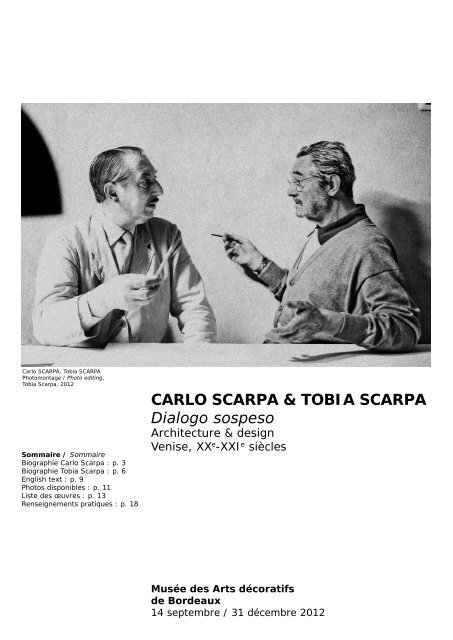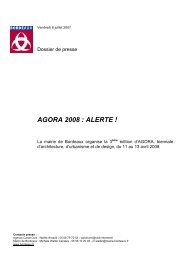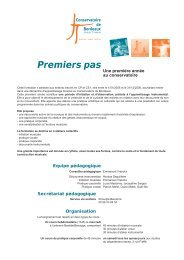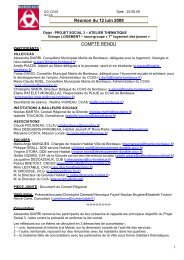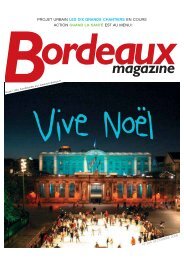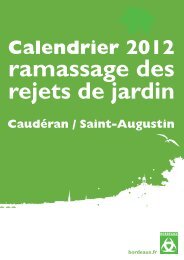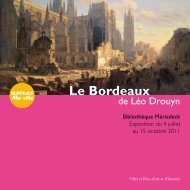Carlo Scarpa, Tobia Scarpa : Dialogo sospeso au ... - Bordeaux
Carlo Scarpa, Tobia Scarpa : Dialogo sospeso au ... - Bordeaux
Carlo Scarpa, Tobia Scarpa : Dialogo sospeso au ... - Bordeaux
You also want an ePaper? Increase the reach of your titles
YUMPU automatically turns print PDFs into web optimized ePapers that Google loves.
4<strong>Carlo</strong> <strong>Scarpa</strong> a généralement dessiné du mobilier dans le contextede ses projets d’architecture. L’on pourra difficilement dans soncas parler d’un processus de design– projet et fabrication- quianticiperait pour chaque objet sa fabrication en série. Les quelquespièces présentées à titre exceptionnel dans l’exposition restentcohérentes avec le travail de l’architecte, combinant rigueurmoderniste et raffinement artisanal.En revanche, c’est par le dessin que <strong>Carlo</strong> <strong>Scarpa</strong> préparait la miseen œuvre de ses architectures et l’intervention des différents corpsde métiers. Comme la gestuelle du chef d’orchestre <strong>au</strong>tour d’unepartition, leur mise en couleurs, leur précision, l’attention portéesur quelques détails essentiels viennent préciser la tonalité poétiquedu projet à exécuter : l’exposition propose de découvrir un choixexceptionnel de dessins totalement inédits à ce jour, réalisés <strong>au</strong>tourde quelques projets encore peu connus.<strong>Carlo</strong> <strong>Scarpa</strong>Repères chronologiques<strong>Carlo</strong> <strong>Scarpa</strong> naît à Venise en 1906 ; son père est instituteur. Jusqu’àl’âge de 13 ans et la mort de sa mère, la famille vit à Vicence - villedu Palladio- avant de se réinstaller à Venise. En 1920 le jeune <strong>Carlo</strong>est admis à l’Académie des Be<strong>au</strong>x-Arts de Venise où il obtient en1926 un diplôme de dessinateur d’architecture. Durant ses étudesil travaille dans l’agence d’un architecte vénitien, Vincenzo Rinaldo.Jeune diplômé, il assiste déjà le professeur Guido Grilli à la facultéd’architecture de Venise avant d’y être chargé de cours en 1933, àl’âge de 27 ans.Il se marie en 1934 à Onorina Lazzari, et leur fils <strong>Tobia</strong> naît en1935. Il collabore à la verrerie Cappelin de Murano commeconseiller artistique, puis travaille chez Venini où pendant 14 ansil va expérimenter les possibilités plastiques du verre et crée sespremiers objets.Dès le début des années 30, <strong>Carlo</strong> <strong>Scarpa</strong> a son propre bure<strong>au</strong>d’étude. Il intervient dans l’aménagement de nombreux magasinsd’appartements, de villas et de sites culturels : décorationintérieure de la Société des arts décoratifs de Venise (1935),transformation du Théâtre Rossini (1937) et toujours à Venise,première intervention à l’Université de la Ca’ Foscari en 1935.Sa longue collaboration avec la Biennale de Venise commenceen 1942. Pendant trente ans il interviendra comme architecte enparticulier pour le Pavillon italien, le pavillon du Livre, le Jardinde sculptures, le pavillon du Venezuela et comme scénographe denombreuses expositions temporaires.
8Dans son activité d’architecte, <strong>Tobia</strong> <strong>Scarpa</strong> a travaillé <strong>au</strong>ssi bienpour des particuliers dont il a réalisé les habitations, que pour lesindustriels et les grandes firmes. Sa collaboration avec LucianoBenetton est à ce titre emblématique.Au début des années 60, Afra et <strong>Tobia</strong> <strong>Scarpa</strong> rencontrent LucianoBenetton; alors qu’ils n’ont encore <strong>au</strong>cune expérience d’architecte,il leur demande de dessiner la première Usine Benetton à PonzanoVeneto. En recherche de sa propre identité créative, <strong>Tobia</strong> veut alorsse démarquer de son père. Avec le soutien de Benetton, les <strong>Scarpa</strong>se sont alors entendus pour éviter les schémas traditionnels. Lebâtiment de 1964 reprend l’architecture d’une ferme traditionnelle :une grande cour séparant les espaces de fabrication et les bure<strong>au</strong>x.De petites maisons groupées forment comme un village de bure<strong>au</strong>x.Tout a été fait pour ne pas perturber l’harmonie du paysage et lesparkings sont souterrains. La structure de l’usine avec ses poutresformant un « X » deviendra la forme d’origine pour le logo de lamarque. L’usine est équipée d’un système d’air conditionné etles aménagements sont réalisés pour que le bâtiment reçoive unmaximum de lumière naturelle. Ces préoccupations étaient vraimentrévolutionnaires pour l’époque et l’usine de Ponzano est apparuealors comme une architecture d’avant-garde dans un environnementrural. Le bâtiment se révéla vite trop étroit et Afra Bianchin et<strong>Tobia</strong> <strong>Scarpa</strong> furent chargés de la conception d’une nouvelle aile.Les projets se sont alors enchaînés formant un véritable complexequi s’étend sur 15 000 hectares sur les sites de Ponzano Veneto etCastrette di Villorba.Dans les années 90, le nombre croissant de manifestationsculturelles et d’expositions en Europe a engendré la rénovationet la reconversion de constructions historiques pour les accueillir.A deux reprises, les <strong>Scarpa</strong> ont été amenés à participer à ce typede chantiers. Au Palazzo Brusati Bonasi à Capri en 1994 et <strong>au</strong>Palazzo Bomben de Trévise. Ces projets ont été suivis en 2000, parla rénovation du Palazzo della Ragione à Vérone et de la GrandeAccademia à Venise. <strong>Tobia</strong> <strong>Scarpa</strong> excelle dans la protection deséléments d’architecture d’origine tout en adaptant ces bâtiments àleurs nouvelles destinations.Le chantier de la Grande Accademia tient une place à part dans sacarrière. L’architecte qui, depuis 2000 poursuit sa carrière seul, setrouve <strong>au</strong> contact de l’une des plus importantes collections du mondeexposées dans un édifice médiéval; il doit composer non seulementavec l’héritage de Palladio intervenu <strong>au</strong> XVIème siècle, mais <strong>au</strong>ssicelui de son père (1945-1952) qu’il conserve tout en apportant sapropre vision contemporaine.Depuis 2002, comme son père avant lui, <strong>Tobia</strong> <strong>Scarpa</strong> enseigne àl’Université d’architecture de Venise.
9Since 2003, the Museum of Decorative Arts of Borde<strong>au</strong>x organizesregularly exhibitions of design. This year, the museum presents thework of the venetian architect <strong>Tobia</strong> <strong>Scarpa</strong> and the work of his father,<strong>Carlo</strong>, who died in 1978 and with whom he was first an apprendice, thena business partner. <strong>Tobia</strong> took an active role in the organization of thisexhibition which gathers, for the first time, the work of both creators.<strong>Carlo</strong> <strong>Scarpa</strong> (1906 Venice–1978 Sendai, Japan)More than thirty years after his death, <strong>Carlo</strong> <strong>Scarpa</strong> (1906 Venice–1978Sendai, Japan) is still considered one of Italy’s more important architects.During his long career from the 20’s until the 70’s, most of his work is settledin Venetia. His name is renown due to the rest<strong>au</strong>rations of historical buidingssuch as the Correr museum, the Castelvecchio museum, and the Querinifondation among others.<strong>Carlo</strong> <strong>Scarpa</strong> spent much of his early childhood in Vicenza wherehis family relocated when he was two years old. After his mother'sdeath, when he was thirteen, the family moved back to Venice. <strong>Carlo</strong>attended the Academy of Fine Arts where he focused on architecturalstudies with the architect Francesco Rinaldo. <strong>Scarpa</strong> married Rinaldo'sniece, Onorina Lazzari. Graduated from the Accademia, he became aprofessor of Architecture. <strong>Scarpa</strong> t<strong>au</strong>ght drawing and interior decorationat the Istituto universitario di architettura di Venezia from the late 1940s.Simultaneously he began to collaborate to Venini glass factory of Murano.His architecture is deeply sensitive to the history of the buildings and thecities; he was also a great observer of the changes of seasons. Althoughmost of his built work is located in the Veneto region, he also made projectsfor other regions of Italy as well as foreign countries.One of his last projects, left incomplete at the time of his death, wascompleted in 2006 by his son <strong>Tobia</strong>: the Villa Palazzetto in Monselice.Besides the mentioned projects, <strong>Scarpa</strong>’s most significant works are theGipsoteca Canoviana at the Canova Museum in Possagno (1955-1957), theCastelvecchio museum in Verona (1954-1956), and the Fondazione QueriniStampalia, Venice (1961-1963) where his great awareness of the city’shistory provides a new dimension. One of the most ambitious landscape andgarden projects of his career is the Brion Sanctuary at San Vito d’Altivole inVeneto, realized between 1969 and 1978.Other works that cannot go unnoticed are the Venice Biennale Pavilions, andseveral refurbishing and extensions of Venice museums such as Correr andAccademia museums, and the refurbishing of private places such as CasaVeritti, Udine, Casa Balboni, Venice, Casa Ottolenghi, Verona.After his death in 1978 in Sendai, Japan, <strong>Carlo</strong> <strong>Scarpa</strong> was buried in Brionfamily cemetery. In 1984, the Italian composer Luigi Nono dedicated him thecomposition A <strong>Carlo</strong> <strong>Scarpa</strong>, Architetto, Ai suoi infiniti possibili.
10<strong>Tobia</strong> <strong>Scarpa</strong> (Venice, 1935)<strong>Tobia</strong> <strong>Scarpa</strong>, <strong>Carlo</strong> <strong>Scarpa</strong>’s son, has been working in architecture anddesign for almost 40 years. First with Afra Bianchin, then alone, he hasdesigned objects, furniture, lamps, office buildings, houses, factories,museums, and showrooms –more than 400 realizations–. In all his work wefind be<strong>au</strong>tiful experiments of the potential of the materials, the change of therelationships between forms and functions, and a new understanding of thespace where they reside.The first design pieces of <strong>Tobia</strong> <strong>Scarpa</strong> dates back to 1957 at the PaoloVenini's glass factory in which his father worked during years. In 1957, hemeets Afra Bianchin (Montebelluna, on 1937 - Trevignano, on 2011) at theIstituto Universitario di Architettura di Venezia. For a test at the Istituto, hedesigns a prototype of a wooden chair, the armchair Pigreco, an example ofsimplicity, that is edited first by Santabona, then by Gavina. During almost40 years, they imagined design objects: furniture, lamps edited by bigmanufacturers (Knoll, Molteni, Maxalto, Flos), while leading at the same timearchitect's activity.In 1970, their armchair Soriana was rewarded with the Compasso d'Oro.Generally <strong>Tobia</strong> <strong>Scarpa</strong>'s seats are made by elements such as constructionsets. The chair Libertà from 1989 is an assembly of two parts folded andscrewed. Afra Bianchin and <strong>Tobia</strong> <strong>Scarpa</strong> drew tens of lamps, most for a newbrand: Flos. Thanks to the manufacturing process Cocoon, they created thelamp Fantasma, then the lamp Jucker. In 1968, they designed the table lamp,Biagio, made of Carrara marble; they also designed the floor lamp Papillona,and created a large collection of silversmith objects for San Lorenzo.At the beginning of the 60’s, Afra and <strong>Tobia</strong> <strong>Scarpa</strong> met Luciano Benettonwho asked them to draw the first Benetton factory in Ponzano. At thatmoment, <strong>Tobia</strong> wanted to distance himself from his father, and was seekingfor his creative identity. The factory of Ponzano appears then as cutting edgearchitecture in a rural environment. The further projects for Benetton form areal complex which extends today on 15 000 hectares.In the 90’s, the increasing number of cultural events in Europe engenderedthe renovation and the reconversion of historic constructions to accommodatethem. <strong>Scarpa</strong> participates in this type of construction sites, to Palazzo BrusatiBonasi in Capri in 1994, to Palazzo Bomben of Trevise, followed by Palazzodella Ragione in Verona and the Grande Accademia in Venice. <strong>Tobia</strong> <strong>Scarpa</strong>excels at the protection of the historical architecture elements while adaptingthese buildings to their new destinations.
11Photos disponibles / Available pictures<strong>Carlo</strong> SCARPA, vers 1967(Venise, 1906 – Sendai, Japon, 1978)© Luciano Svegliado<strong>Carlo</strong> SCARPA(Venise, 1906 – Sendai, Japon, 1978)Sculpture Crescita© Alberto Vendrame, Studio <strong>Scarpa</strong><strong>Carlo</strong> SCARPA(Venise, 1906 – Sendai, Japon, 1978)Casa Balboni, Venise (1964-1974)© Alberto Vendrame, Studio <strong>Scarpa</strong><strong>Carlo</strong> SCARPA(Venise, 1906 – Sendai, Japon, 1978)Complexe monumental Brion,1969-1978, San Vito© Alberto Vendrame, Studio <strong>Scarpa</strong>
12<strong>Tobia</strong> <strong>Scarpa</strong>(Venise, 1935)Cérémonie de remise du Compassod’oro, 26 juin 2008 à Veneria Reale(Turin)© Riccardo Crosetta<strong>Tobia</strong> <strong>Scarpa</strong>(Venise, 1935)Carafe Moretta, 1990© <strong>Tobia</strong> <strong>Scarpa</strong><strong>Tobia</strong> <strong>Scarpa</strong>(Venise, 1935)Lampe Biagio, 1968Editions Flos© Editions Flos<strong>Tobia</strong> <strong>Scarpa</strong>(Venise, 1935)F<strong>au</strong>teuil Pigreco, 1959Editée par Santabona,entre 1960 et 1962Collection privée© Giorgio Furla<strong>Tobia</strong> <strong>Scarpa</strong>(Venise, 1935)Etablissements Benetton à Castrettedi Villorba (Vénétie) : Passerelle, 2011© Luca Lagrecacolonna
13Liste des œuvres / Works in the exhibition<strong>Tobia</strong> SCARPA, Afra Bianchin, 1959-1999<strong>Tobia</strong> SCARPA, 1999-2011ArchitectureDessins, plans etphotographies de réalisations /Architecture. Drawings, plants,picturesMaglieria Benetton, 1964-1986Usine de tricotPlans, photographiesPaderno di Ponzano Veneto(Trévise)Maison de Luciano Benetton, 1966DessinsPaderno di Ponzano Veneto(Trévise)Villa Minelli, 1968-1994Dessins, plans, photographiesBenetton Group,Ponzano Veneto (Trévise)Maison <strong>Scarpa</strong>, 1980Dessins, photographiesTrevignano, TréviseCentrale thermique, 1983Complexe industriel Benetton,Castrette di Villorba, TréviseUsine « division laine », 1985Complexe industriel Benetton,Castrette di Villorba, TréviseUsine Benetton Jeans e Capispalla,1992Dessins, plans, photographies,Castrette di Villorba, TréviseVilla Loredan, 1992Aménagements extérieurs etsouterrains,Plans, photographiesPaese, TréviseMercato Vecchio di Verona, 2000Rest<strong>au</strong>rationDessins, photographiesVéroneMaison Cacchione, 2006Dessins, photographiesMilanEntrepôt de stockage robotisé,1980 et extension 2007Dessins, photographiesCastrette di Villorba, TréviseVilla Il Palazzetto, 2009(Après <strong>Carlo</strong> <strong>Scarpa</strong>)Réaménagement des accèsà la villaDessins, photographiesMonselice, Padua,Cantina Fattoria delle Ripalte,2010Construction d’un rest<strong>au</strong>rantd’entreprisephotographiesRipalte - Capoliveri, Ile d’Elbe(Livourne)Magasin Ex Lana, 2011Benetton Group, conversiond’une nef industriellePhotographiesPonzano VenetoAccademia di Venezia 2011(Après un aménagement par<strong>Carlo</strong> <strong>Scarpa</strong>)Aménagement de nouvellesgaleriesDessins, photographiesVeniseHôtel Relais Monaco, 1999Benetton Group,Paderno di Ponzano Veneto,Trévise
14Mobilier / FurniturePrototype de la chaise Pigreco,1960 (1959)Éditée par Santabona puispar GavinaCollection <strong>Tobia</strong> <strong>Scarpa</strong>,Mogliano VenetoLit Vanessa, 1962acier verni et pliéÉdition GavinaCollection <strong>Tobia</strong> <strong>Scarpa</strong>,Mogliano VenetoChaise 1965-121Bois, cuirEdition CassinaCollection <strong>Tobia</strong> <strong>Scarpa</strong>,Mogliano VenetoSofa Coronado, 1966Mousse polyuréthane, métal, cuirEdition B & B ItaliaF<strong>au</strong>teuil <strong>Carlo</strong>tta, 1967Bois, tissuEdition CassinaCollection <strong>Tobia</strong> <strong>Scarpa</strong>,Mogliano VenetoF<strong>au</strong>teuil Ciprea, 1968mousse polyuréthane et tissuEdition CassinaF<strong>au</strong>teuil Soriana, 1969Edition CassinaCuir f<strong>au</strong>ve, métalCollection particulière, FloiracChaises et table Artona, 1975Modèle AfricaEnsemble comprenant 4 chaiseset une tableEdition MaxaltoCollection particulière, ToulouseVitrines Artona, 1977Bois de diverses essences, verreEdition MaxaltoColl. part. ToulouseCollection <strong>Tobia</strong> <strong>Scarpa</strong>,Mogliano VenetoChaise Veronica, 1985Mousse de polyuréthane, cuirEdition Casas mlsChaise Libertà, 1989Metal plié, tissuEdition MeritaliaChaise Boomerang 1993Bois, metal, cuir ou tissuEdition MeritaliaChaise Oscarina, 2004MultipliEdition Merotto e MilaniLuminaires / LampsLampe Fantasma, 1961Edition FlosGalerie Galvani Design, ToulouseJucker, 1963Lampe de tableEdition FlosPerpetua, 1981Lampe de tableMétal verni noir, verreEdition FlosLampe Foglio, 1966Applique muraleMétal pliéEdition FlosBiagio, 1968Lampe de tableMarbreEdition FlosAriette, 1973Plafonnier ou appliqueEdition FlosGalerie Galvani Design, ToulouseTamburo, 1973Lampe d’extérieurMétal laqué, verreEdition FlosPapillona, 1975LampadaireAcier, verreEdition FlosMusée des arts décoratifs,Borde<strong>au</strong>x
15Abatina, 1981Lampe de tableAluminium extrudé, PVC, tissuEdition FlosCollection particulière ToulouseCelestia, 1982plafonniertoile de lin, métalEdition FlosLampe Capalonga, 1982Cuivre, porcelaineCollection particulièreLampe Pierrot, 1990Métal peintCollection André Vossen, BruxellesRay, 2004Système d’éclairageAcier, verre, lampes halogènesEditions MizarObjets et Orfèvrerie /Objects and silver piecesVaso poligonale – 1971VaseArgentEditions San Lorenzo, MilanScatole, 1972Boîtes rectangulaire et carréeArgent matEditions San Lorenzo, MilanCarafe Moretta, 1990PrototypeLaiton marteléMusée des arts décoratifs,Borde<strong>au</strong>xDon de M. Ciro CacchioneCarafe Moretta , 1990Argent martelé, vermeilEditions San Lorenzo, MilanAluminio, 1992Assiettes, plats, bolsAluminium coloréEditions San Lorenzo, MilanBandierine Segnavento, 1992ensemble de girouettes sur piedAluminium verni,tige télescopique et contrepoidsen acier inoxydableEdition Dimensione FuocoCollection André Vossen, BruxellesCiotole cartoccio, 1996bols-cornetArgentEditions San Lorenzo, MilanCasseruola, 1999CasseroleAcier inoxidable, cuivreEditions San Lorenzo, MilanMusina, 2001TirelireArgentEditions San Lorenzo, MilanTaste-vin cup, 2004Tasse à vinArgentEditions San Lorenzo, MilanVases Centenaio, 2006ArgentEditions San Lorenzo, MilanVases Venini, 2006Série de vases de verre de couleurVenini & C., Murano, VeniseCiao Papà, 2006Série de vases de verre de couleurLeucosNew Jersey, USA
16<strong>Carlo</strong> SCARPA (1906-1978)Dessins d’architecture /Architecture drawingsBiennale de Venise, Pavillon Italiende la Biennale, 1952-1972Dessins,Archives de La Biennale, VeniseGipsoteca Canoviana,Gypsothèque du Musée Canova,1955-1957PhotographiesPossagno, TréviseShowroom Olivetti, 1957-1958PhotographiesPiazza San Marco, VeniseMaison Veritti, 1955-1961Dessins origin<strong>au</strong>x, photographies,maquetteUdineFondation Querini Stampalia,1961-1963PhotographiesSanta Maria Formosa, CastelloVenisePalazzo Abatellis, Galerie régionalede Sicile, 1963PhotographiesPalerme, SicileMaison Zentner, 1964Dessins origin<strong>au</strong>x, photographies,maquetteZurich, SuisseMaison Balboni, 1964-1974Dessins, esquisses, croquis etcoupes d’architectureDorsoduro, VeniseEnsemble monumental ettombe<strong>au</strong> de la Famille Brion,1969-1978Dessins origin<strong>au</strong>x, esquisses,croquis, coupes d’architecturephotographies, maquette,Cimetière de San Vito d’Altivole,TréviseVilla Il Palazzetto, 1974-1975Dessins origin<strong>au</strong>x, photographies,maquetteMonselice, PadoueMaison Ottolenghi, 1974-1979Dessins origin<strong>au</strong>x, photographiesBardolino, VéroneDessins, dessins d’exécutionProjets de meublesCollection particulière, ItalieDessins,Collection Archives d’Etat deTrévise,Centre d’étude <strong>Carlo</strong> <strong>Scarpa</strong>Mobilier / FurnitureF<strong>au</strong>teuilProvenant de la Casa Pellizzari,1942Érable sycomore et noyerColl. part. ParisChaise,Provenant de la Casa Pellizzari,1942Hêtre noirci, garniture d’origine àmotif floral japonisantGalerie Yves Gastou, ParisPaire d’appliques, 1942Provenant de la Casa PellizzariVerre opalin de Venini,bras de lumière en bronze à patinecanon de fusilGalerie Yves Gastou, ParisDoge, Ultrarazionale Collection,1968tableVerre, acierEdition Simon, Thiene, VicenzaZibaldone, 1976bibliothèquesBois, acier, verreEdition Bernini
17Orfèvrerie /Objects and silver piecesCarafe en argent et argentmartelé. vers 1977Édition Cleto Munari. VicenzaGalerie Galvani Design, ToulouseCentre de table en argent,vers 1977Édition Cleto Munari. VicenzaGalerie Galvani Design, ToulouseSculptures et objets rares /Sculptures and rare objectsCrescitaBois de deux essences,socle en marbreCollection châte<strong>au</strong> La Roccadi MonseliceCrescitaBois, socle en marbreCollection châte<strong>au</strong> La Roccadi MonseliceCrescitaBois, socle en métalCollection châte<strong>au</strong> La Roccadi MonseliceContafilimétal et agatesCollection châte<strong>au</strong> La Roccadi MonseliceVerrerie / GlasswareEnsemble d’objetsAnnées 1935 à 1950Créés pour la verrerie Venini & C.,MuranoCollection <strong>Tobia</strong> <strong>Scarpa</strong>, MoglianoVenetoCollection Ferruccio Franzoia,Feltre, BellunoCollection châte<strong>au</strong> de La Roccadi Monselice
18Renseignements pratiques /Practical InformationMusée des Arts décoratifsde Borde<strong>au</strong>x39, rue Bouffard - 33000Borde<strong>au</strong>xTel : +335 56 10 14 00Fax : +335 56 10 14 01musad@mairie-borde<strong>au</strong>x.frwww.borde<strong>au</strong>x.frExpositionOuverte tous les jours,s<strong>au</strong>f mardis et jours fériésde 11h à 18h /Everyday execept Tuesday andbank holidays, from 11.00 to 6 pmSamedis et dimanchesde 14h à 18h /Saturday & Mondayfrom 2 pm to 6 pmTarif d’entrée : 5 €Tarif réduit : 2,50 €Visites commentées / Guidedtourslundi à 16h, mercredi à 12h30,samedi à 16h /Saturday & Monday at 4 pmWednesday at 12.30Catalogue<strong>Carlo</strong> <strong>Scarpa</strong> et <strong>Tobia</strong> <strong>Scarpa</strong><strong>Dialogo</strong> <strong>sospeso</strong>, cataloguede l’exposition / Catalogue ofexhibitionTextes / Texts de Francesco dal Co,Bernadette de Boysson,Philippe Duboy64 pages, 13X21cm, N&B /Black & WhiteVersions française, anglaise,italienne / Français, English,ItalianoPrix de vente : 5 €Conférences<strong>Carlo</strong> <strong>Scarpa</strong> et <strong>Tobia</strong> <strong>Scarpa</strong>Architecture et design à Venise, dela modernité à la contemporanéitéPar François Guillemete<strong>au</strong>dMardi 16 octobre à 15h et 18hSalle de conférence dumusée des Arts décoratifsInformations service culturel+33(0)5 56 10 14 05Partenaires du musée /Sponsors & PartnersLes Amis de l’hôtel de LalandeQuattro BeneluxBenettonAir FranceChapon FinLacoste traiteur (Groupe AROM)Châte<strong>au</strong> de L<strong>au</strong>nayChâte<strong>au</strong> NairacGrand Hôtel de Borde<strong>au</strong>x & SpaInformations presse /Press InfoMusée des Arts décoratifsNathalie Balerdi Paternotten.balerdipaternotte@mairieborde<strong>au</strong>x.fr+335 56 10 14 03Mairie de Borde<strong>au</strong>xDirection de la communication,service presse+335 56 10 20 46sce.presse@mairie-borde<strong>au</strong>x.frPresse nationale et internationaleCl<strong>au</strong>dine Colin Communicationsamya@cl<strong>au</strong>dinecolin.com+331 42 72 60 01www.cl<strong>au</strong>dinecolin.comborde<strong>au</strong>x.fr


